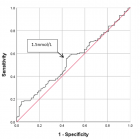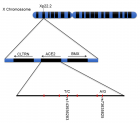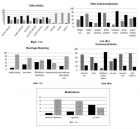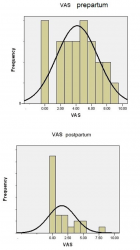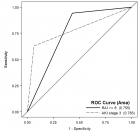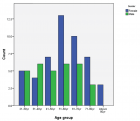Abstract
Research Article
Management of Popliteal Artery aneurysms: Experience in our center
Michiels Thirsa and Vleeschauwer De Philippe*
Published: 25 January, 2018 | Volume 2 - Issue 1 | Pages: 001-009
Background: Popliteal artery aneurysms (PAAs) are rare, but the diagnosis should not be missed because of the limb and life threatening complications. The purpose of this study was to reach a consensus about the management of PAA based on our own experience and the available literature.
Materials and Methods: This is a retrospective analysis of all patients who underwent an open surgical PAA repair at our institution from January 2015 to December 2016. Demographic data, risk factors, clinical presentation, aneurysm characteristics, type of repair and results were reviewed. Results include patency and major complications.
Results: Seven patients underwent an open surgical PAA repair (six men). Median age was 72 years. A posterior approach (PA) was chosen four times and a medial approach (MA) was chosen three times. We performed six resections with interposition of a graft and only one ligation with a bypass. Five patients recovered well, did not develop any complication and did not need a second intervention to guarantee patency. These patients underwent a resection of the aneurysm and interposition of a graft (four via a PA and one via a MA). One patient treated by resection and interposition of a Dacron graft via a MA underwent an above-the-knee amputation at postoperative day 14. This patient had a preoperatively dysfunctional leg since several months with no patent outflow vessels. Our patient treated by ligation and bypass via a MA, developed an acute ischemia four months postoperatively because of an extreme flexion of the knee during several hours while watching TV. After unsuccessful trombolysis, he underwent a femorotibial bypass and a partial forefoot amputation. No long-term results are yet available.
Conclusions: In our opinion, open surgical repair of PAAs by resection of the aneurysm and interposition of a venous graft has the best results. Depending on the relation to the knee joint and thus the accessibility of the aneurysm, a posterior approach is preferred. We are not convinced of endovascular techniques in the treatment of popliteal artery aneurysms
Read Full Article HTML DOI: 10.29328/journal.avm.1001003 Cite this Article Read Full Article PDF
Keywords:
Popliteal artery aneurysm; Posterior approach; Open surgical repair
References
- Pittathankal A, Dattani R, Magee T, Galland R. Expansion Rates of Asymptomatic Popliteal Artery Aneurysms. Eur J Vasc Endovasc Surg. 2004; 27: 382-384. Ref.: https://goo.gl/DnDAvb
- Galland R. Popliteal Aneurysms: From John Hunter to the 21st Century. Ann R Coll Surg Engl. 2007; 89: 466-471. Ref.: https://goo.gl/4vdCYe
- Szilagyi DE, Schwartz RL, Reddy DJ. Popliteal Arterial Aneurysms. Arch Surg. 1981; 116: 724. Ref.: https://goo.gl/oQkzXi
- Anton G, Hertzer N, Beven E, O'Hara P, Krajewski L. Surgical management of popliteal aneurysms. J Vasc Surg. 1986; 3: 125-134. Ref.: https://goo.gl/XTdjYL
- Carpenter J, Barker C, Roberts B, Berkowitz H, Lusk E, et al. Popliteal artery aneurysms: Current management and outcome. J Vasc Surg. 1994; 19: 65-73. Ref.: https://goo.gl/oVDSQq
- Michaels J, Galland R. Management of asymptomatic popliteal aneurysms: The use of a markov decision tree to determine the criteria for a conservative approach. Eur J Vasc Surg. 1993; 7: 136-143. Ref.: https://goo.gl/tJfUUP
- Claridge M, Hobbs S, Quick C, Adam D, Bradbury A, et al. Screening for popliteal aneurysms should not be a routine part of a community-based aneurysm screening program. Vasc Health Risk Manag. 2006; 2: 189-191. Ref.: https://goo.gl/yjBif8
- Bowyer R, Cawthorn S, Walker W, Giddings A. Conservative management of asymptomatic popliteal aneurysm. Bri J Surg. 1990; 77: 1132-1135. Ref.: https://goo.gl/4mRzq2
- Neiman H, Yao J, Silver T. Gray-Scale Ultrasound Diagnosis of Peripheral Arterial Aneurysms. Radiology. 1979; 130: 413-416. Ref.: https://goo.gl/xzm3k1
- Rizzo R, Flinn W, Yao J, McCarthy W, Vogelzang R, et al. Computed tomography for evaluation of arterial disease in the popliteal fossa. J Vascu Surg. 1990; 11: 112-119. Ref.: https://goo.gl/1XvQRL
- Schellack J. Nonoperative Management of Selected Popliteal Aneurysms. Archives of Surgery. 1987; 122: 372-375. Ref.: https://goo.gl/qS9HD2
- Lowell R, Gloviczki P, Hallett J, Naessens J, Maus T, et al. Popliteal Artery Aneurysms: The Risk of Nonoperative Management. Ann Vasc Surg. 1994; 8: 14-23. Ref.: https://goo.gl/N2moXQ
- Shortell C, DeWeese J, Ouriel K, Green R. Popliteal artery aneurysms: A 25year surgical experience. J Vasc Surg. 1991; 14: 771-779. Ref.: https://goo.gl/o7XTTk
- Mahmood A, Salaman R, Sintler M, Smith S, Simms M, et al. Surgery of popliteal artery aneurysms: A 12-year experience. J Vasc Surg. 2003; 37: 586-593. Ref.: https://goo.gl/N5dGYU
- Dawson I, Sie R, van Bockel J. Atherosclerotic popliteal aneurysm. Bri J Surg. 1997; 84: 293-299. Ref.: https://goo.gl/CQqBFo
- Aulivola B, Hamdan A, Hile C, Sheahan M, Skillman J, et al. Popliteal artery aneurysms: a comparison of outcomes in elective versus emergent repair. Journal of Vascular Surgery. 2004; 39: 1171-1177. Ref.: https://goo.gl/4WhPMi
- Cervin A, Tjärnström J, Ravn H, Acosta S, Hultgren R, et al. Treatment of Popliteal Aneurysm by Open and Endovascular Surgery: A Contemporary Study of 592 Procedures in Sweden. Eur J Vasc Endovasc Surg. 2015; 50: 342-350. Ref.: https://goo.gl/Jz6ujV
- Mazzaccaro D, Carmo M, Dallatana R, Settembrini A, Barbetta I, et al. Comparison of posterior and medial approaches for popliteal artery aneurysms. J Vasc Surg. 2015; 62: 1512-1520. Ref.: https://goo.gl/aDVS5F
- Ravn H, Wanhainen A, Björck M. Surgical technique and long-term results after popliteal artery aneurysm repair: Results from 717 legs. J Vasc Surg. 2007; 46: 236-243. Ref.: https://goo.gl/JrnAwt
- Antonello M, Frigatti P, Battocchio P. Open Repair versus Endovascular Treatment for Asymptomatic Popliteal Artery Aneurysm: Results of a Prospective Randomized Study. J Vasc Surg. 2005; 42: 185-193. Ref.: https://goo.gl/Qb1tEc
- Tielliu I, Verhoeven E, Zeebregts C. Endovascular Treatment of Popliteal Artery Aneurysms: Results of a Prospective Cohort Study. J Vasc Surg. 2005; 41: 561-566. Ref.: https://goo.gl/t1HREB
- Pulli R, Dorigo W, Castelli P, Dorrucci V, Ferilli F, et al. A Multicentric Experience with Open Surgical Repair and Endovascular Exclusion of Popliteal Artery Aneurysms. Eur J Vasc Endovasc Surg. 2013; 45: 357-363. Ref.: https://goo.gl/xjJ3bJ
- Von Stumm M, Teufelsbauer H, Reichenspurner H, Debus E. Two Decades of Endovascular Repair of Popliteal Artery Aneurysm-A Meta-analysis. Eur J Vasc Endovasc Surg. 2015; 50: 351-359. Ref.: https://goo.gl/KGMnNk
Figures:

Figure 1

Figure 2
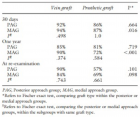
Figure 3
Similar Articles
-
Management of Popliteal Artery aneurysms: Experience in our centerMichiels Thirsa,Vleeschauwer De Philippe*. Management of Popliteal Artery aneurysms: Experience in our center. . 2018 doi: 10.29328/journal.avm.1001003; 2: 001-009
Recently Viewed
-
Impact of Refractive Error Correction on Vision Related Quality of Life in School-Aged Children-A Prospective Interventional StudyAshok Rathi*,Sonam Gill,RS Chauhan,Jyoti Deswal,Abhishek Sagar,Nipun Rathi. Impact of Refractive Error Correction on Vision Related Quality of Life in School-Aged Children-A Prospective Interventional Study. Int J Clin Exp Ophthalmol. 2025: doi: 10.29328/journal.ijceo.1001061; 9: 011-017
-
The “sweet” relations between diabetes and plateletsNikolaos Neokleous*,Stavroula Mpountola,Vasileios Perifanis. The “sweet” relations between diabetes and platelets. J Hematol Clin Res. 2022: doi: 10.29328/journal.jhcr.1001019; 6: 001-003
-
Role of RBC Parameters to Differentiate between Iron Deficiency Anemia and Anemia of Chronic DiseasesReena Bhaisare*, Ravindranath M, Gurmeet Singh. Role of RBC Parameters to Differentiate between Iron Deficiency Anemia and Anemia of Chronic Diseases. J Hematol Clin Res. 2023: doi: 10.29328/journal.jhcr.1001024; 7: 021-024
-
Return to Driving in Mild Traumatic Brain Injury: Evaluation of Coping Strategies, Resilience, and Psychological DistressTisha J Ornstein*,Erica S Reyvas,Maire L O’Hagan,Samantha R Pejic. Return to Driving in Mild Traumatic Brain Injury: Evaluation of Coping Strategies, Resilience, and Psychological Distress. Insights Depress Anxiety. 2025: doi: 10.29328/journal.ida.1001043; 9: 001-011
-
Development and Evaluation of a mHealth app - (ReMiT-MS app) for Rehabilitation of Individuals with Relapsing-remitting Multiple Sclerosis - A Mixed Methods, Pragmatic Randomized Controlled Trial - Study ProtocolSolaiyan Rajanchellappa, Dheeraj Khurana*, AGK Sinha, Soundappan Kathirvel, Ashok Kumar, Rajni Sharma. Development and Evaluation of a mHealth app - (ReMiT-MS app) for Rehabilitation of Individuals with Relapsing-remitting Multiple Sclerosis - A Mixed Methods, Pragmatic Randomized Controlled Trial - Study Protocol. J Nov Physiother Rehabil. 2024: doi: 10.29328/journal.jnpr.1001060; 8: 022-030
Most Viewed
-
Feasibility study of magnetic sensing for detecting single-neuron action potentialsDenis Tonini,Kai Wu,Renata Saha,Jian-Ping Wang*. Feasibility study of magnetic sensing for detecting single-neuron action potentials. Ann Biomed Sci Eng. 2022 doi: 10.29328/journal.abse.1001018; 6: 019-029
-
Evaluation of In vitro and Ex vivo Models for Studying the Effectiveness of Vaginal Drug Systems in Controlling Microbe Infections: A Systematic ReviewMohammad Hossein Karami*, Majid Abdouss*, Mandana Karami. Evaluation of In vitro and Ex vivo Models for Studying the Effectiveness of Vaginal Drug Systems in Controlling Microbe Infections: A Systematic Review. Clin J Obstet Gynecol. 2023 doi: 10.29328/journal.cjog.1001151; 6: 201-215
-
Prospective Coronavirus Liver Effects: Available KnowledgeAvishek Mandal*. Prospective Coronavirus Liver Effects: Available Knowledge. Ann Clin Gastroenterol Hepatol. 2023 doi: 10.29328/journal.acgh.1001039; 7: 001-010
-
Causal Link between Human Blood Metabolites and Asthma: An Investigation Using Mendelian RandomizationYong-Qing Zhu, Xiao-Yan Meng, Jing-Hua Yang*. Causal Link between Human Blood Metabolites and Asthma: An Investigation Using Mendelian Randomization. Arch Asthma Allergy Immunol. 2023 doi: 10.29328/journal.aaai.1001032; 7: 012-022
-
An algorithm to safely manage oral food challenge in an office-based setting for children with multiple food allergiesNathalie Cottel,Aïcha Dieme,Véronique Orcel,Yannick Chantran,Mélisande Bourgoin-Heck,Jocelyne Just. An algorithm to safely manage oral food challenge in an office-based setting for children with multiple food allergies. Arch Asthma Allergy Immunol. 2021 doi: 10.29328/journal.aaai.1001027; 5: 030-037

HSPI: We're glad you're here. Please click "create a new Query" if you are a new visitor to our website and need further information from us.
If you are already a member of our network and need to keep track of any developments regarding a question you have already submitted, click "take me to my Query."






